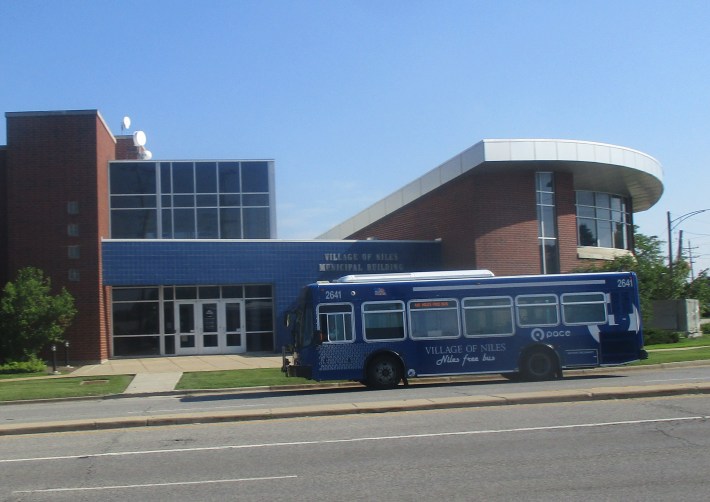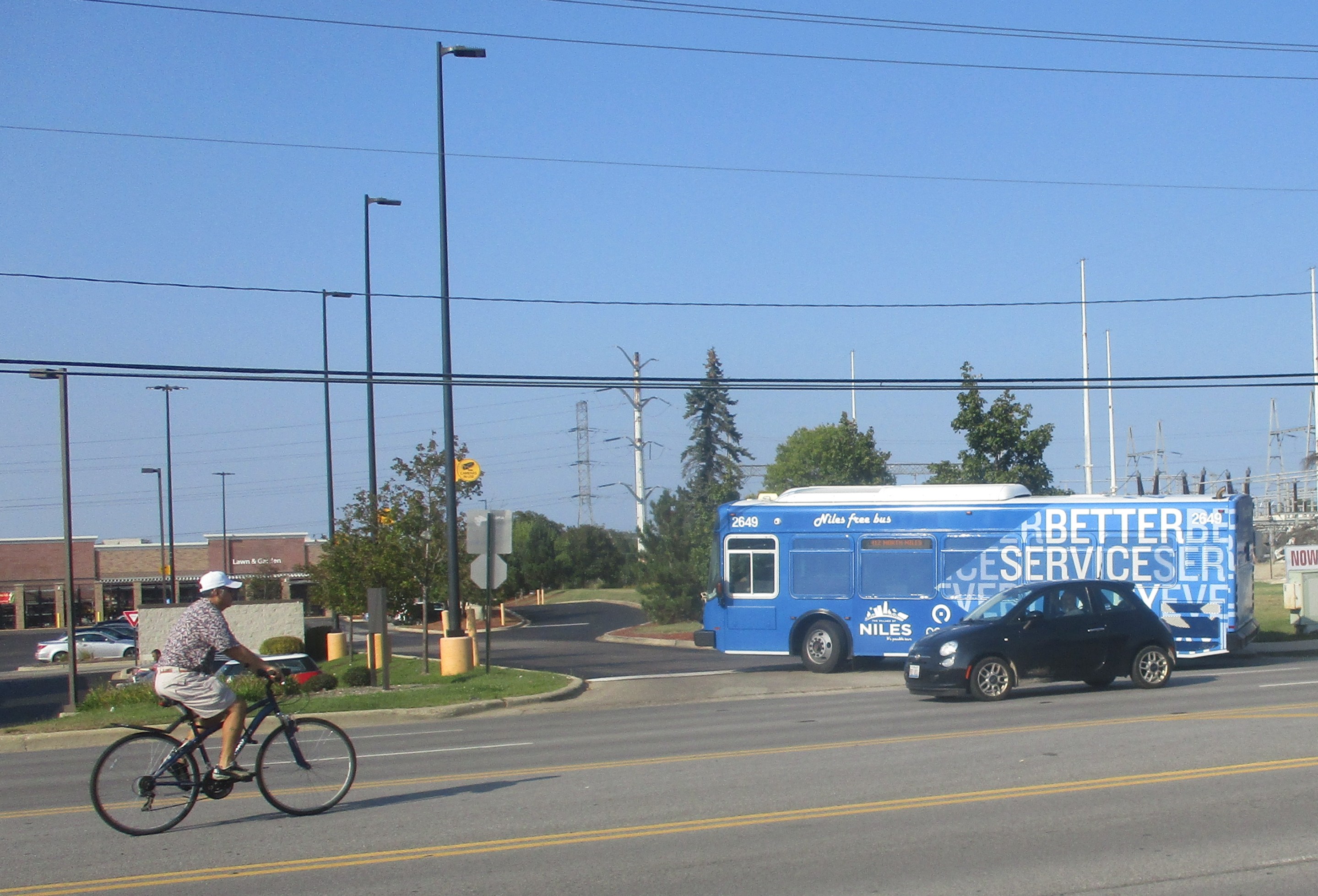Back in April, My Block, My Hood, My City's Jahmal Cole argued that CTA services should be free. Streetsblog Chicago looked into the issue, as well as at how having free or reduced fared could help low-income residents get access to jobs and resources. But it's worth noting that the Chicago area already has some free bus services, most notably in northwest suburban Niles.
Niles Free Bus
Northwest suburban Niles has the Niles Free Bus system – three Pace routes that serve most of the village at no cost to riders. Village officials have argued that it provides an important service, especially for residents who need it most – seniors and people with disabilities. And they noted that, with service improvements implemented two years ago, riders benefit from more consistent service frequency, and improved weekend service and transit connections.
The Niles Free Bus system started out as a service operated by the Niles Park District, according to village spokesperson Mitch Johnson. In 1972, the park district set up two routes that used two school buses in order to make it easier for residents to travel between its facilities. “Community interest was generated in this kind of service and the park district approved transfer of the bus service to the village in the first quarter of 1973,” he said. “[The village of Niles] officially began operating in the third quarter of 1973.”
The village started operating one loop-like route that went through most of the village. It was structured so that residents would be able to reach all major civic, retail and recreational destinations without having to walk too far to or from a bus stop.

On Sept. 9, 1975, the Regional Transit Authority began providing some funding, and federal grants were used to purchase new buses. Some time in the next few years, the North Suburban Mass Transit District (or “Nortran” for short), one of the several public transit providers that would eventually merge into Pace, began helping with funding as well. “Gradually. over time, the arrangement became more formalized, and now there is an annual agreement signed by the Village for the Pace service,” Johnson said.
In 1983, the village added a second route to serve the retail and residential areas on Niles' north end. In 1996, it added another route to serve the southeastern portion of Niles – the traditionally industrial area that, by that point, was starting to see retail development. As the Pace network became more of a unified system, the original Niles loop became Pace Route 411, while the north service became Route 412 and the south service became Route 413.
From 2014 to 2016, Pace and the Village of Niles conducted a study to determine how to make the bus system more efficient and better integrated with the rest of the Pace system. Effective May 2, 2016, the original loop was split into the portion east of Milwaukee Avenue, which became Route 410, and the portion west of Milwaukee Avenue, which retained Route 411 numbering. The routing of both half was tweaked, shifting service based on ridership demand. Pace did make them “paired routes” -- once Route 410 reaches its end point, it continues as Route 411, and vice-versa.
Route 413 was eliminated, but the southern ends of the two remaining routes were extended to continue providing service to some of the busier portions of the defunct route. Route 412 remained largely the same, though, as with the loop, some of the routing was changed based on ridership patterns.
According to Pace spokesperson Maggie Daly Skogsbakken, today the village of Niles covers about 40 percent of the cost of operating the Niles Free Bus system. The drivers are village employees, and the village's department of public Works maintains the buses. While the buses use the regular Pace blue-with-white-lettering color scheme, they have “Niles Free Bus” written prominently on the sides. Following the 2016 service revamp, lettering on the buses became bigger, and the larger service logo started to appear on buses, bus schedules and bus stop signs.
Other free bus services
The city of Highland Park operates free shuttle bus service from parking lots to the Ravinia Festival grounds. The festival covers the entire cost of the service.
Pace Route 811, also known as Rosemont Circulator, links the Rosemont Blue Line ‘L’ station to convention centers, commercial areas and entertainment destinations south of Jane Addams Memorial Tollway. Pace's Impact Field Direct route provides more direct service between the Rosemont stop and Impact Field before and after Chicago Dogs American Association league baseball games. Daly Skogsbakken said that the Rosemont buses are funded using the similar formula as Niles Free Bus system, with Rosemont covering 40 percent of the costs and Pace covering the rest.
Finally, the Schaumburg Trolley links together major shopping areas throughout the Village of Schaumburg and Pace’s Northwest Transportation Center, one of the area’s major bus hubs. Daly Skogsbakken explained that the Village of Schaumburg and Pace spilt the costs 40/60 for Friday-Sunday service during most of the year. But the village covers the cost for Monday-Thursday service, as well as all service between Thanksgiving and New Year’s.
Is It Worth it?
Niles spokesperson Johnson said that, for Fiscal Year 2019, which runs between July 1, 2018 and June 30, 2019, the village budgeted $1,471,336 for the Free Bus. However, it should be noted that this includes Pace’s 40 percent share of the funding. Pace does its budgets by the January to December calendar year, so an apples-to-apples comparison is impossible, but the transit agency’s 2018 budget shows that Niles is expected to contribute $554,000 toward covering the estimated $1,538,000. That $554,000 is only 0.6 percent of Niles' $92 million-plus FY 2019 budget, but it's still nothing to sneeze at.
The 2016 Niles service changes highlighted one limitation of the current funding mechanism. Because the amount of funding the village and Pace provide haven’t changed significantly, adding to one aspect of bus service meant taking away from another. After May 2016, the service started earlier, but it also ended earlier.

Still, Johnson noted, Route 413 was weekday-only, but replacing it with portions of Routes 410 and 411 allows Niles Free Bus to provide weekend service to some of the destinations the discontinued route used to serve, such as the Leaning Tower YMCA and Village Crossing shopping plaza.
As noted during the Niles Free Bus study, as of 2014, only 750 riders a day used the three routes in a village whose population is 29,617. Furthermore, Niles is served by some of the busiest Pace routes in the entire system. Route 290, which serves Touhy Avenue, is the second-busiest Pace route.
The ridership statistics compiled by RTA suggest that this figure hasn’t changed much since the service overhaul. 2016 saw an average of 736 riders a day, while 2017 saw an average of 746 riders. But, as the study noted, those riders are also more likely to need free transit. Seniors and people with disabilities account for a greater proportion of riders on Niles Free Bus routes then they do on most of Pace’s routes.
This was especially evident during the July 23, 2015 public hearing on the service changes, when seniors showed up in force to speak out against removing the direct service to two Niles senior care facilities and removing service on the section of Milwaukee Avenue south of Touhy Avenue. In response, Pace wound up reducing service to the senior care facilities instead of eliminating it altogether and working with the village to issue special Ventra cards that allow seniors to take Route 270 bus, a paid Pace route that serves Milwaukee Avenue, for free within Niles village limits.

As the service change study noted, the greater-than-average proportion of seniors and people with disabilities may be due to the fact that those routes take longer to travel between destinations. The fact that buses stop much closer to the entrances to the Niles-Maine District Library and stores and many village shopping plazas is useful to people with mobility issues, but this ease of access may not be as much of a priority for other riders.
Johnson said that, overall, Niles is happy to be able to provide Niles Free Bus service. “The goal has always been to provide a safe community transportation service to our residents and others from surrounding areas to address their various needs in Niles, like medical, shopping to Pointe Plaza, Village Crossing, Dempster Plaza and Golf Mill [Shopping Center], visiting the [Niles] Senior Center, [Niles-Maine] Library, recreation Centers, the Village Hall, etcetera," he said. “The service has been very successful, with over millions of riders since its inception, and has served our community for 45 years.”






